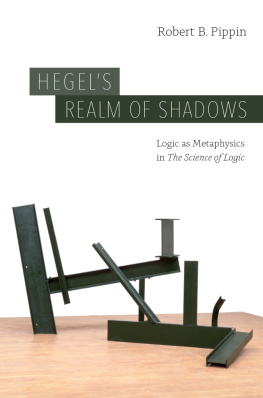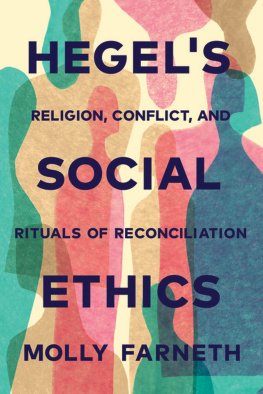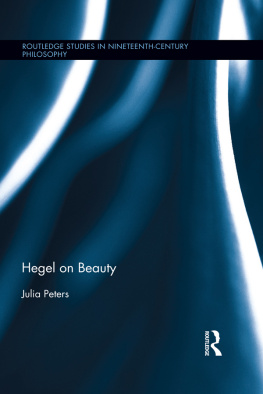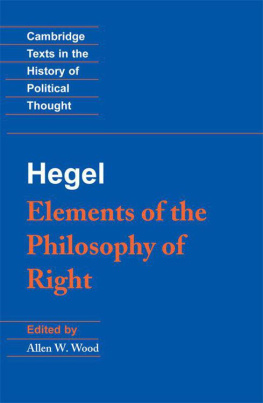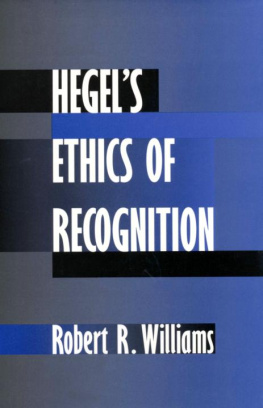Hegels Political Aesthetics
Also Available from Bloomsbury
Political Aesthetics: Addison and Shaftesbury on Taste, Morals and Society , Karl Axelsson
The New Aesthetics of Deculturation: Neoliberalism, Fundamentalism, and Kitsch , Thorsten Botz-Bornstein
Hegel on Possibility: Dialectics, Contradiction, and Modality , Nahum Brown
From Marx to Hegel and Back: Capitalism, Critique, and Utopia , ed. Victoria Feld and Hannes Kuch
The German Idealism Reader , ed. Marina F. Bykova
Hegels Political Aesthetics
Art in Modern Society
Edited and with an Introduction
by
Stefan Bird-Pollan and Vladimir Marchenkov

Contents
Stefano da Verona. The Crucifixion (ca. 1400). Tempera on wood, gold ground, 33 20 in. The Metropolitan Museum of Art, New York |
Pieter Bruegel the Elder. The Harvesters (1565). Oil on wood, 46 63 . The Metropolitan Museum of Art, New York |
Frans Hals. Merrymakers at Shrovetide (ca. 161617). Oil on canvas, 51 39 in. Metropolitan Museum of Art, New York |
Jan Steen. The Dissolute Household (ca. 166364). Oil on canvas, 42 35 in. The Metropolitan Museum of Art, New York |
Jeff Wall, A View from an Apartment , 200405, transparency in lightbox, 167 244 cm |
For the past several centuries, the history of Western ideas about art has unfolded under the dual aegis of two unequal and mutually opposed currents. The first and older one, going back to Plato and even further into the mythological strata of ancient Mediterranean cultures, can be called the moralist view. It consists in setting moral concerns over and above all others in judgments about art. The second and newer one, distinctly modern, can be described as aesthetic . Unlike moralism, it treats artistic expression not only as having its own intrinsic value but also as entirely independent and separate from morality. The aesthetic sensibility as such is not something specifically modern or Western; it can be found in pre- and nonmodern cultures as well. What distinguishes the aesthetic sensibility in the modern period is that, rather than being a marginal element, it moves closer to, and sometimes right into, the center of cultural interests and concerns. In pre- and nonmodern settings, aesthetic sensibility manifests itself most clearly in the creation of and admiration for the culturally marginal objects that arouse aesthetic pleasure, but it can also be present in the valuation of works and practices in the center of cultural life. And yet, despite this seemingly central position, it remains marginal. Attic tragedy, for example, was a truly substantive aesthetic phenomenon, but in the eyes of the ancient Greek society it was first and foremost a civic-religious ritual whose aesthetic component, while distinctly present, was secondary at best. Generally speaking, premodern European cultures, both ancient and medieval, thought of what today is called their art chiefly in moralist terms, and the aesthetic view proper was gradually taking shape in moralisms shadow during the Renaissance and the Baroqueuntil it finally matured and emerged as a challenge to moralism at the end of the Enlightenment. In Alexander Baumgartens Aesthetica , this aesthetic view received its initial open philosophical recognition, and half a century later Immanuel Kants Critique of the Power of Judgment gave it the authoritative form in which it is recognized to this day. Kants notion of the aesthetic remains complicated. While the Critique of Judgment emphasizes the notion of reflective judgment already adumbrated in the Critique of Pure Reason as central to all theoretical judgment, in particular judgments of taste and judgments of teleology, Kant also insists that philosophy must be fundamentally understood as in the service of practical reason. Judgments employing reflective judgments, while they underlie their determinative counterparts, cannot themselves yield cognition.
Kants elaboration of the aesthetic perspective, often considered the pillar and exemplum of formalism and aesthetic autonomy by later commentators, was thus haunted by the older moralism. This was the case, incidentally, for the Enlightenment as a whole, and in this regard Kant did not part ways with Jean-Jacques Rousseau or Denis Diderot. When we speak of Baumgartens Aesthetica and Kants Critique of the
It may seem that the romantics liberated art from the hegemony of moralism, but they merely imitated the gestures of the enlightened moralist by inverting them: romanticism elevated art over and above everything elsemorality, religion, and philosophywhich resulted in an alternative but hardly more sensible standpoint. Still, as a result, the philosophical debate about art from the early nineteenth century on finally acquired two fully distinct poles, moralism and aestheticism, whose problematic mutual conjunction, in fact, had always constituted the driving engine of the history of the arts but until that moment had remained largely hidden. Hegels philosophy of art can be seen as a response to this intense dialectic and a heroic attempt to move beyond both the moralism of the Enlightenment and the romantic exaggeration of arts role. He sought to find a place for art in his overall system, a place that would at once reflect arts unique role in human affairs and link it to other human pursuitsabove all, the pursuit of knowledge and truth. In this quest he created a body of thought that looms large over the subsequent history of aesthetic debates to this day, but it would be an overstatement, to say the least, to claim that his achievement brought about anything remotely resembling a consensus. Quite the contrary, the history of aesthetics from the second third of the nineteenth century to our time is a theater of war where various permutations of the two basic attitudes battle with one other. Their interactions do not boil down, of course, to mere conflict; sometimes they fuse to produce partial and temporary syntheses. But the story of these interactions has not unfolded along a Hegelian trajectory; it has not resulted in a dialectical reconciliation of opposites and remains to this day at the level of the abstract understanding, in a permanent crisis. The pendulum of theoretical attitudes toward art in mature and late modernity swings from one side to the other, now to formalist aestheticism, now to didactic moralism (to say nothing of flagrant ideologism). Hegel liked to quote Horaces dictum: Et prodesse et delectare volunt poetae (The poets wish at once to instruct and to delight), but prodesse and delectare , to be useful and to delight, are forever at odds in the modern artists work.
The essays collected in this book examine precisely this discomfort, by peering into the aesthetic-ethical conundrum in Hegels thought. The book does not deliver a unified argument because the authors perspectives are too diverse, and the editors set themselves no such goal. What brings the authors together is rather their overlapping interests in similar questions and problematic areas in Hegels philosophy of art, the chief among them being, as we just pointed out, the conjunction of the aesthetic understanding of art, on the one hand, and the moral, social, or political implications of Hegels position, on the other. Many of the chapters display also a critical engagement with Hegel, questioning his opinions and procedures, highlighting unresolved dilemmas, pointing up unfinished and incomplete projects, exposing internal contradictions and inconsistencies, and ways of carrying Hegels arguments further than Hegel himself did. The only thing on which the authors seem to agree is that Hegels philosophy of art remains relevant, stimulating, and, in fact, vital to our own attempts to come to terms with art as an indispensable part of being human.






